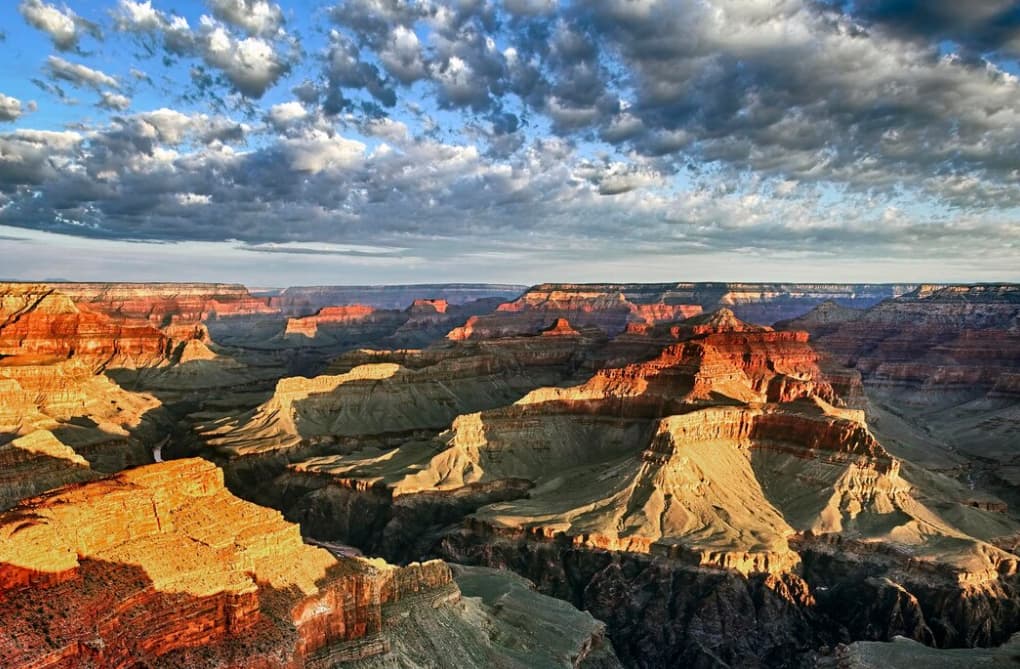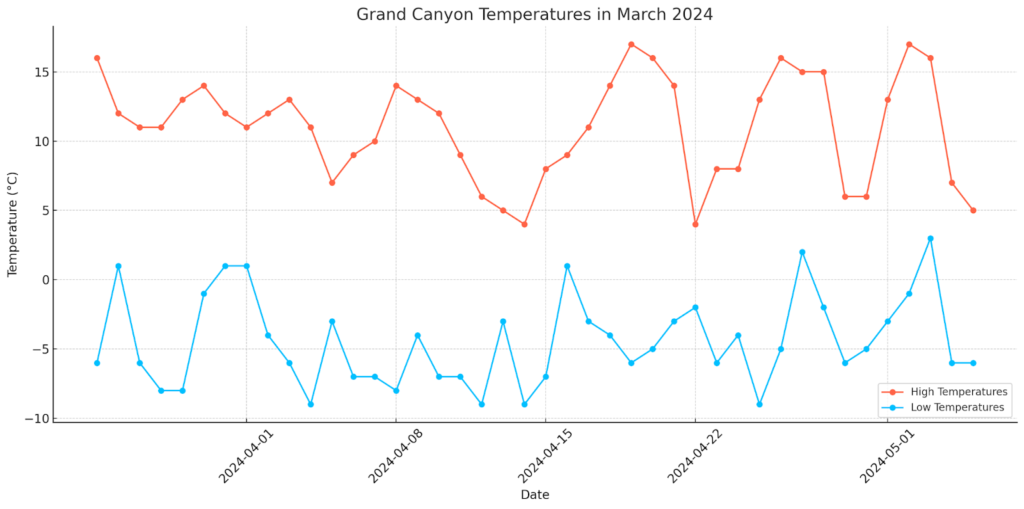Understanding the Grand Canyon’s climate is essential when planning a trip. The temperatures and precipitation vary by location and time of year. Here is a complete analysis detailing the monthly temperatures and precipitation at the South Rim, Phantom Ranch, and North Rim.
Understanding the seasonal temperature fluctuations of the Grand Canyon can provide valuable insights into planning excursions, such as exploring the historic Hopi Salt Trail.
Monthly Weather at the South Rim
The South Rim’s climate exhibits a range of temperatures throughout the year. January and February are the coldest months, with high temperatures averaging 41°F and 45°F, respectively, and the lows dropping to 18°F and 21°F. As spring rolls around in March, temperature highs rise to 51°F, while lows hover around 25°F. April brings warmer weather, with highs reaching 60°F and lows climbing up to 32°F.
May ushers in the warmth with a high temperature average of 70°F and a low of 39°F. June sees further escalation, boasting highs of 81°F and lows of 47°F. July and August are the peak summer months, with highs of 84°F and 82°F, respectively, and lows around 54°F.
Moving into autumn, September offers highs of 76°F and lows of 47°F. October’s temperatures drop slightly with highs at 65°F and lows at 36°F. November introduces the start of winter with highs back down to 52°F and lows at 27°F. December, the coldest month, hosts high temperatures of 43°F and lows of 20°F.
Monthly Weather at Phantom Ranch
Phantom Ranch, nestled in the heart of the Grand Canyon, experiences more extreme temperatures compared to the South Rim. January’s average high temperature is 56°F, with lows at 36°F. February sees a slight increase, hosting highs of 62°F and lows of 42°F.
The arrival of spring in March escorts in highs of 71°F with lows at 48°F. April continues in the upward temperature trend with highs of 82°F and lows of 56°F. May witnessed a dramatic increase, hitting highs of 92°F and lows of 63°F.
The sweltering summer months of June, July, and August bring highs of 101°F, 106°F, and 103°F respectively, with lows ranging from 72°F to 78°F. The heat slightly subsides in September with highs of 97°F and lows of 69°F.
As autumn approaches, October sees a significant drop to 84°F for highs and 58°F for lows. November’s highs dip to 68°F with lows at 46°F. The year rounds off with December’s more relaxed highs of 57°F and lows of 37°F.
Monthly Weather at the North Rim
The North Rim is generally colder than the South Rim and Phantom Ranch. January and February are the chilliest months, with highs averaging 37°F and 39°F and lows around 16°F and 18°F. Spring’s arrival in March increases highs to 44°F, while lows rise to 21°F.
April ushers in warmer weather with highs of 53°F and lows of 29°F. May continues this upward trend with highs of 62°F and lows of 34°F. Summer kicks in with June, July, and August experiencing average highs of 73°F, 77°F, and 75°F respectively, and lows from 40°F to 46°F.
Autumn starts dropping temperatures with September logging highs of 69°F and lows of 39°F. October’s temperatures are notably cooler with highs at 59°F and lows at 31°F. November introduces the winter chill with high temperatures at 46°F and lows at 24°F. December rounds out the year with highs at 40°F and lows around 20°F.
Monthly Precipitation in the Grand Canyon
| Location | JAN | FEB | MAR | APR | MAY | JUN | JUL | AUG | SEP | OCT | NOV | DEC |
|---|---|---|---|---|---|---|---|---|---|---|---|---|
| South Rim | 1.32 | 1.55 | 1.38 | 0.93 | 0.66 | 1.81 | 1.81 | 2.25 | 1.56 | 1.10 | 0.94 | 1.64 |
| Inner Canyon | 0.68 | 0.75 | 0.79 | 0.47 | 0.36 | 0.84 | 0.84 | 1.40 | 0.97 | 0.65 | 0.43 | 0.87 |
| North Rim | 3.17 | 3.22 | 2.65 | 1.73 | 1.17 | 1.93 | 1.93 | 2.85 | 1.99 | 1.38 | 1.48 | 2.83 |
Rainfall varies across the Grand Canyon’s regions and seasons. The South Rim receives 1.32 inches of rain in January, 1.55 inches in February, and 1.38 inches in March. April sees a decrease to 0.93 inches, and May continues the downward trend with 0.66 inches.
June, July, and August experienced increased rainfall with totals of 1.81 inches, 1.81 inches, and 2.25 inches respectively. September dips slightly to 1.56 inches, October to 1.10 inches, and November further to 0.94 inches. December rounds out the year with a rise to 1.64 inches.
Phantom Ranch, as part of the Inner Canyon, experiences less rainfall with averages from 0.36 inches to 1.40 inches throughout the year.
The damp North Rim sees the most precipitation, with figures ranging from 1.17 inches to a high of 3.22 inches in February.
Best Time to Visit Grand Canyon

Determining the ideal time to visit the Grand Canyon depends on your weather preferences and activities:
- For moderate temperatures and minimal rainfall, consider visiting between April and June or September and November. These periods offer pleasant weather suitable for hiking and sightseeing;
- If you can handle the heat, the summer months provide the longest days and vibrant sunsets. However, ensure you are prepared for sudden monsoon storms during July and August, which can offer a thrilling spectacle;
- The winter offers a uniquely serene vista of a snow-dusted Grand Canyon. January and February are great for those who prefer quieter trails and don’t mind the chill.
Packing Tips for Grand Canyon’s Weather
Having the right gear can make your Grand Canyon visit more comfortable, especially considering the varying weather.
- For summer, pack light clothing, sun hats, sunscreen, and plenty of water;
- In autumn, layers are your friends as the temperature can fluctuate;
- Winter calls for warm clothing, insulated boots, and gloves;
- Spring visitors should pack for mild to warm weather and have rain gear handy.
No matter what season you visit, hiking shoes, a brimmed hat, sunglasses, and a reusable water bottle are essential.
Grand Canyon March 2024: A Glimpse into Temperature Variability

Conclusion
Understanding the Grand Canyon’s monthly temperatures and precipitation can enhance your visit. While weather conditions differ across the South Rim, Phantom Ranch, and North Rim, this detailed guide provides valuable insights to inform your trip planning. Whether you seek the summer heat, milder spring and autumn temperatures, or the tranquil beauty of a winter visit, each season offers a unique perspective of the Grand Canyon.